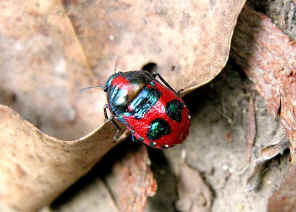|
| |
- Species in this family are know as Jewel Bugs or Shield Backed
Bugs. Bugs in this
family are usually colourful with
metallic colour of spots. They are medium to large size. The head is
triangular, antenna are 3-5 segmented.
-
 -
- Photo thanks to Tracey Steele, Sydney
-
- Jewel Bugs and Shield-backed bugs are plant suckers. They
can be distinguished from other bugs by their scutellum completely covered the
whole abdomen and wings. This is why sometimes they are miss-recognized as beetle. They
are easily distinguished from beetles by having sucking mouthparts
and the shield on the back is continuous, not the divided wings cover with separation
at the middle.
-
- This family are closely related
to stink bugs (Family Pentatomidae). They also produce offensive odors when disturbed.
-
Subfamily Elvisurinae - Shield Backed Bug
- Green Shield Backed Bug

 - Coleotichus sp., body length 20mm
- Found this bug once on Dec 2009 in a hilltop of Anstead Forest. The
bug was camouflaged well on leaves. It was slow moving. It flied away after we
took a few pictures. Please also check this page
for more information.
-
Subfamily Scutellerinae - Jewel Bugs
- Scutellerinae are brightly coloured shield bugs amongst the most striking
colourful insects.
-
- Metallic Jewel Bug, Metallic Shield Bug
  - Scutiphora pedicellata, body length 15mm
- Metallic Shield Bugs can be found on leaf letter or under bark. They feed
on vegetable, garden plants, trees and fruits. The bugs are metallic green in
colour with orange and black patterns on the top. Underside of their body is
bright red and black. More information and pictures can be found by clicking here.
-
-
- Green Jewel Bug

 - Lampromicra senator, body length 12mm
- The bug is metallic dark green in colour, with orange mark on its back. Its
legs are orange and dark green. Under its large shield, we can see the orange
edges of abdomen. We have more information and pictures in this page.
-
-
- Red Jewel Bug
  - Choerocoris paganus, body length 12mm
- In mid summer during bush-walking in the rain forest near Mt Nebo, we saw
this bright red bug resting on a tall glass leaf. When we came closer to take
some photos, the bug dropped onto the ground and run away quickly. Please also
check this page for more details.
-
Subfamily Tectocorinae
- There is only one Australian species in this subfamily.
-
- Cotton Harlequin Bug
 
 - Male
Female
Nymph
Photo: Jeff O'Donnell, Sydney
- Tectocoris diophthalmus, adults body length 20mm, nymph body
length 10mm
- Cotton Harlequin Bugs are colourful. Females are orange with small patches
of metallic blue scattered over their body. Males are metallic blue with red
patches. Their patterns can be quite different between individual. Male are
smaller than the females in size. Adults have their scutellum completely
covered the whole abdomen and wings. More information and pictures please
visit this page.
-
- Reference:
- 1. Insects
of Australia, CSIRO, Division of Entomology, Melbourne University
Press, 2nd Edition 1991, pp 508.
- 2. Insects of Australia, Hangay, George, & German, Pavel, Reed
New Holland, Sydney, 2000, pp 64.
- 3. Scutelleridae
- Australian Biological Resources Study,
Department of the Environment and Heritage, Commonwealth of Australia 2005.
- 4. Revision of the Australian Scutelleridae Leach
(Hemiptera) - FJD McDonald and G Cassis, Australian Journal of Zoology,
1984.
- 5. Plant-feeding and Other Bugs (Hemiptera) of South Australia. Heteroptera-Part
I - Gross, G.F. (1975).
Adelaide: A.B. James, p79.
- 6. SCUTELLERIDAE Shield-backed Bugs - Save Our Waterways Now, 2008.
Back to top
[ Up ] [ Biology ] [ Field Guide ] [ Family Cydnidae ] [ Family Tessaratomidae ] [ Family Scutelleridae ] [ Family Pentatomidae ]
| |
|












